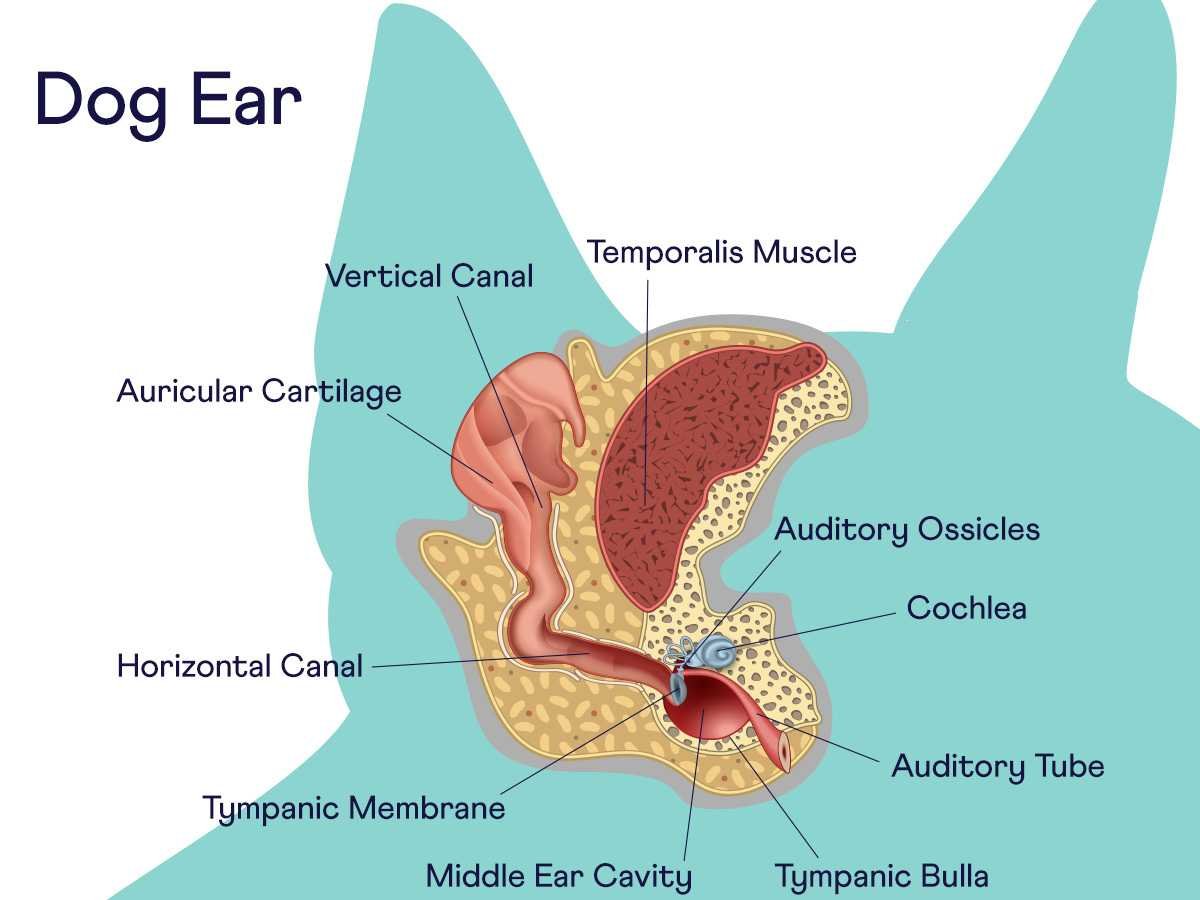Dog Ear Infection: Causes, Diagnosis, and Treatments
Dog ear infections can be a nuisance. Read on to learn more about the causes, symptoms, diagnosis, and treatments of ear infections for dogs.
Ear infections can be external, internal, or in the middle ear region. The symptoms of an ear infection will vary upon the dog, so if you notice something is off with your pup, it never hurts to pay a visit to your veterinarian.
Dogs with long, floppy ears have a higher chance of getting an ear infection, but all dog breeds are susceptible to getting one.
Before you can help your pup out with their ear infection, it’s important to know what can cause it, what symptoms to look out for, treatment options, and how you can prevent future ear infections.
What Are Ear Infections?
Time for introductions: Meet Otitis, the medical term for ear infections.
Ear infections boil down to irritation or discomfort in the ears, and can range from mild to severe.
The ear contains a balance of bacteria and yeast. When irritation or discomfort occurs, the temperature, humidity, and pH inside the ear can rise — this makes for the perfect breeding ground for bad bacteria to live in.
Dogs are more prone to getting ear infections than humans because their ear canals are shaped differently. While dogs' ear canals are more vertical, humans' ear canals are horizontal. Because of the vertical shape, fluids can’t always escape as easily as they do within the human ear. With that, you have the formula for an ear infection.
Causes of Ear Infections
Ear infections are ultimately caused by bacteria getting a foothold somewhere in the ear. Viruses can be a cause, too, but this isn’t as common.
Here are some of the main reasons bacteria can get into (and thrive in) the ear:
Moisture trapped in the ear (especially during baths)
Allergies
A build-up of wax in the ears
Injury that isn’t cleaned properly
Foreign material such as dirt
Cleaning the ear more frequently than is necessary and irritating the tissue
Medical issues like hormone imbalances, parasites, or autoimmune disorders can also result in an ear infection.
Types of Ear Infections
There are three types of infections, and they’re based on location:
Otitis Externa (External)
Otitis Media (Middle)
Otitis Interna (Internal)
Outside of these types of ear infections, your dog may experience ear mites or canine Malassezia (a type of yeast infection).
Regardless of the type of infection, it’s best to talk to your veterinarian and have them be the one to diagnose and treat the ear infection.
Otitis Externa
Otitis Externa is the most common ear infection with dogs. As the name conveys, it affects the outer ear canal. This part of the dog’s ear starts at the ear flap and continues to the ear canal or eardrum.
Otitis Externa is found among all dog breeds, but it is frequently diagnosed in dogs with longer ears. This includes breeds such as Poodles, Beagles, Cocker Spaniels, Labrador Retrievers, and German Shepherds.
Otitis Media and Interna
Located in the middle ear, Otitis Media is typically the result of an external ear infection left untreated.
Otitis Interna is the last type of ear infection dogs can be diagnosed with. It is also the most problematic and severe. In severe cases, Otitis Media and Otitis Interna can cause deafness, facial paralysis, nausea, vomiting, and more if left untreated.
Ear Infection Symptoms
If you notice any of the following symptoms, be sure to take your furry friend to the vet for a check-up and diagnosis.
Common symptoms of an ear infection include:
Persistent scratching of the ears
Redness
Swelling
Bad odor
Discharge that is brown, yellow, or bloody
Frequent shaking of the head or head tilting
Crusting or scabbing around the ears, or even hair loss around the ears
Loss of balance or poor coordination
Interestingly enough, some dogs may have an ear infection but may never show signs of the infection. This speaks to the importance of regularly cleaning your pup’s ears — twice per month is a good rule of thumb to start. Consult your vet for recommendations specific to your pup.
How Is an Ear Infection Diagnosed in Dogs?
For your pup to get properly diagnosed, your vet will use an otoscope to examine their ears. An otoscope is a medical device used to magnify, which is highly beneficial when identifying what may be causing trouble in your pup’s ears.
During the exam, your vet will also likely ask you questions about your pup’s behavior, what they’ve been recently exposed to, and so on.
Some of the questions may include:
When did the first symptoms appear, and what were they?
Does your dog have allergies?
Are there any underlying conditions they need to know about?
What medications, if any, is your dog currently taking?
Is your dog eating and drinking normally?
Do you clean your dog's ears routinely? If so, how often are you cleaning, and what type of cleaning solution do you use?
Have your dog’s ears been exposed to water recently either by swimming, taking a bath, or going to the groomer?
Does your dog have a history of ear infections?
Depending on the root cause of the infection, your vet may recommend some of the following diagnostic tests:
An x-ray, especially if your veterinarian suspects your dog has a middle or an inner ear infection
An allergy test to rule out which allergens are creating the hassle and next steps for treatment
A biopsy in the case they find a mass or lump in your pup’s ear (uncommon)
How Do You Treat Ear Infections in Dogs?
Depending on your pup’s diagnosis, treatment options may vary.
The most common treatment includes a medicated ear cleanser and topical ointment. Your vet may complete the first treatment during the medical examination. Following the vet visit, you will likely be sent home with ear drops and/or an oral medication depending on the infection type and severity.
It’s important for you to follow the instructions provided by your vet and finish the entire course of medication so that your pup’s ear infection gets the full treatment, which can help prevent it from occurring again.
Your veterinarian may prescribe antibiotics for bacterial infections, fungicides for fungal infections, and insecticides for parasite-related infections.
If the discomfort is more than your pup can handle, consider using our Calming Aid to help soothe your pup’s stress during the vet appointment and even at home while they get better. Having meds dropped into your ears every day isn’t exactly the most peaceful time to be a human’s best friend.
Can You Prevent Ear Infections in Dogs?
One of the simplest ways to prevent ear infections is to keep your dog’s ears clean. Cleaning your dog’s ears on a monthly or biweekly basis will help reduce their chances of getting an ear infection.
While cleaning your dog’s ears, check for signs of dirt, scratches, irritation, or discharge, and give those ears a solid sniff. If you identify an unpleasant odor, it’s possible an infection is brewing.
Here are a few tips on how to clean your dog’s ears:
Use an approved cleaning solution in your dog’s ear, massaging it gently into the ear canal from outside of the ear. Doing so helps to break up any debris located inside of the ear, and moves it upwards to be removed.
Using sterilized absorbent gauze, carefully wipe out the ear canal. You can also use cotton-tipped sticks to make sure you clean all of the crevices and folds on your dog’s ear flap. However, don’t use them in the ear canal itself, as this can push the dirt down deeper into the canal.
If you are not comfortable cleaning your dog's ears yourself, don’t fret. Consult a trusted groomer or vet for regular grooming services.
There may be cases where your vet will need to flush your pup’s ears, especially if there is a build-up of dirt or debris.
The Bottom Line
If you believe your dog is suffering from an ear infection, take them to your regular vet as soon as you can. While most ear infections are easily resolved with medication, they can worsen quickly if left untreated.
Also, while it can be fairly easy to tell at home if your pup has an ear infection, you should leave the diagnosing to the docs — they have the tools to be able to see deeper into the ear and properly assess what’s going on.
For more advice to help give your sidekick the best you can give, explore the Finn blog here!
Sources:
Dog Ear Infections: Symptoms, Causes, Treatment, and Prevention | American Kennel Club
How to Help Prevent Dog Ear Infections | American Kennel Club
Keeping Your Dog's Ears Healthy: Listen to Your Vet | American Kennel Club






